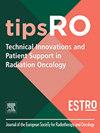患者使用1.5 T MR-Linac治疗头颈部的经验:ATS-lite适应性解决方案是否可耐受?
IF 2.8
Q1 Nursing
Technical Innovations and Patient Support in Radiation Oncology
Pub Date : 2025-07-21
DOI:10.1016/j.tipsro.2025.100324
引用次数: 0
摘要
在Unity MR-Linac (MRL) (Elekta AB, Stockholm, Sweden)上治疗头颈癌(HNC)已经开发出使用新型适应形状Lite (ATS-lite)方法来创建临床可接受的适应性治疗,无需临床医生。在这里,我们调查病人的经验和接受这种技术。方法纳入在PERMIT试验(NCT03727698)中接受mri引导自适应放疗(MRIgART)治疗的30组65 Gy的HNC患者。收集的数据包括患者人口统计,治疗时间和患者经验,使用既定的MRL问卷。为了防止遗漏分数,设计了备份方案,用于CT导引下的常规直线管。收集并分类使用频率以反映原因。结果ats - life法的中位总治疗时间为39 min, 60 min以下的治疗率为98.8%。问卷回复率85%,个别问题回复率99%。96%的回答在李克特量表上得分为2或3分,这是一个积极的答案。得分最低的问题是“我强迫自己管理局面”,平均(标准差)为2.4(0.9)。MRL提供了84.7%的治疗。备用计划用于46个分数,其中7个归因于患者耐受性(n = 2例)。结论ATS-lite HNC MRIgART的平均治疗时间可接受,且比报道的ATP治疗时间更快。病人报告的体验是非常积极的。由于患者缺乏耐受性,备用计划的使用率很低。这种技术可以放心地使用,病人的体验不会受到负面影响。本文章由计算机程序翻译,如有差异,请以英文原文为准。
Patient experience of head and neck treatment on a 1.5 T MR-Linac: is the ATS-lite adaptive solution tolerable?
Introduction
Head and neck cancer (HNC) treatment on the Unity MR-Linac (MRL) (Elekta AB, Stockholm, Sweden) has been developed using the novel adapt-to-shape Lite (ATS-lite) method to create clinically acceptable adaptive treatments clinician-free. Here we investigate patient experience and acceptability of this technique.
Methods
Ten HNC patients treated to 65 Gy in 30 fractions with MRI-guided adaptive radiotherapy (MRIgART) within the PERMIT trial (NCT03727698), were included. Data collected comprised patient demographics, treatment time, and patient experience, using an established MRL questionnaire.
Back-up plans were created for use on the conventional linac with CT guidance, to prevent missed fractions. The frequency of use was collected and categorised to reflect the cause.
Results
The median total treatment time for ATS-lite method was 39 min. The percentage of treatments under 60 mins was 98.8 %.
Questionnaire response rate was 85% and individual question response rate was 99%. Ninety-six percent of responses scored 2 or 3 on the Likert scale, a positive answer. The lowest scoring question was “I forced myself to manage the situation,” with a mean (SD) of 2.4 (0.9).
The MRL delivered 84.7 % of treatments. The back-up plan was used for 46 fractions, 7 attributed to patient tolerance (n = 2 patients).
Conclusion
Average treatment times for the ATS-lite HNC MRIgART are acceptable and faster than reported ATP treatment times. Patient-reported experience was extremely positive. Use of back-up plans attributable to lack of patient tolerance was low. This technique can used with the confidence that patient experience is not negatively impacted.
求助全文
通过发布文献求助,成功后即可免费获取论文全文。
去求助
来源期刊

Technical Innovations and Patient Support in Radiation Oncology
Nursing-Oncology (nursing)
CiteScore
4.10
自引率
0.00%
发文量
48
审稿时长
67 days
 求助内容:
求助内容: 应助结果提醒方式:
应助结果提醒方式:


